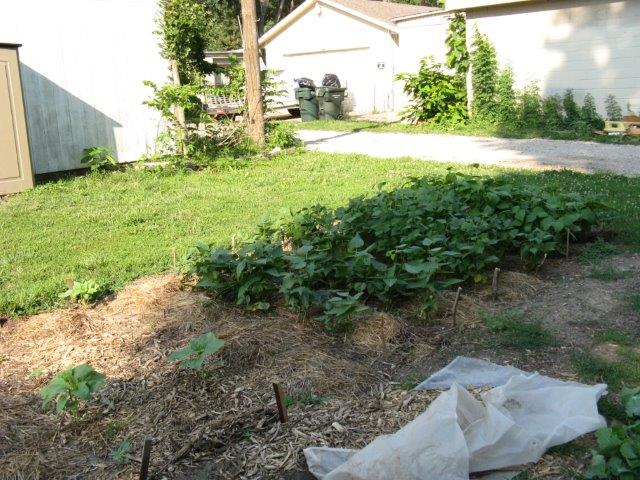Trinity Lutheran reaches out to neighbors by providing space for a garden on our vacant lot. The garden, first organized in 2012, is known as the Historic Old Town Community Garden. Members of Trinity, neighbors, Sunday School children and neighborhood children have planted their own plots the garden. God's generous gift of garden produce as well as the gift of friendship is appreciated by all who participate. We look forward to another good year!
. . .to include nice, neat rows with mulch. (Although my grandma said you could plant more in a crooked row!)
And it is still growing! More beds have been added, along with raised beds and an irrigation system.
And when harvest time comes, the gardeners move into the kitchen to preserve the fruits of their labors.
A little history of the garden:
The beginning thought of a vegetable garden happened when the Outreach Committee of Trinity Lutheran Church was involved in the Partnership for the Missional Church program. As they were looking for ways to reach out to people in this inner city neighborhood, members Walt & Helen Laughlin read an article by Michael Keith Olson titled "Growing Community" in the April 2011 issue of "The Lutheran" magazine. Together they commented "that's a good idea! We could try a community garden in the vacant lot adjoining our church. We're trying to reach out to meet our neighbors, aren't we?"
What happened next as a whole series of events as one thing lead to another. The idea was brought to the attention of the Outreach Committee and discussed further. Chairman Dean McGinnis thought is a good idea. Several already established community gardens around town were contacted and it was learned that Topeka already had the Topeka Common Ground Association inplace and from which we could learn the steps to get organized. Other help came from the County Extension Service, Master Gardeners, and the internet. Members of the congregation came to several of the organizational meetings. At their October 2011 meeting, the Church Council approved the proposal to proceed with the garden on the vacant lot of the church property. The Old Town Neighborhood Improvement Association was also contacted and they were excited to join hands with Trinity in this venture. Kathryn Hosfelt, NIA chair, was enthused about the project. The Bridge, (a neighborhood group which reaches out to mentor children with needs) was also open to being involved, as was St. John's Lutheran Church.
Walt Laughlin volunteered to draw up plot plans of various sizes with help and guidance from the Topeka Common Ground Association representative. The final plan included five plots for children and 13 other plots of various sizes. Walt then proceeded to till the soil in the plots. Volunteers from both the church and they neighborhood helped to spread shredded leaves and manure on the plots. Donna Allen, Gay & Carol Marker, Ted Quast, Dean McGinnis, and Susan Fitz volunteered to represent Trinity in future planning.
During the winter months, the thought of how to get water to the garden during the next growing season was a real concern. That would be an expense. Where would the funds come from? Helen Laughlin, an active member of Trinity's Women of the ELCA, read about a grant program offered by WELCA Raising Up Healthy Women and Girls in the WELCA "Gather" magazine. She submitted a grant application by the December 15 deadline and in March, it was learned that $1,000 would be awarded for the garden. The check was received in early May. This money, thankfully received, was used to pay for a water spigot, soil amending, fertilizer, garden tools, a small shed to hold the equipment, and water bills. Further financial help came from small grants from Walmart and Lowe's for seeds, plants, tools, etc.
Everyone from the church and the community who had shown an interest in the garden were called set up an organizational meeting. A board was formed with Walt Laughlin as coordinator, Kathryn Hosfelt, Old Town NIA representative, Jenna Seematter, secretary, and Gavin Vavra, representing The Bridge, at large.
Right away, soil was amended with sulfur and nitrogen to get it ready for planting.
In mid May, planting began. Homes in the neighborhood were visited and at planting time, ten adults and 12 children were involved. Some seeds and plants were purchased and some were donated. The children were enthused about planting pumpkin, melon, sunflowers, lettuce, carrots, and tomatoes, while the adults planted asparagus, onions, many varieties of tomatoes, parsley, spinach, broccoli, squash, pease, beets, lettuce, potatoes, peppers, okra, green beans, radishes, cantaloupe, petunias, marigolds and much more! Most of the people were first time gardeners and comments were positive: "this has changed my life" and "it has been a wonderful way to meet people in the neighborhood." Many pictures were snapped and there was lots of garden talk.






Ways to Follow Us…